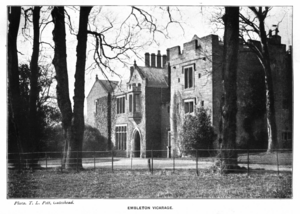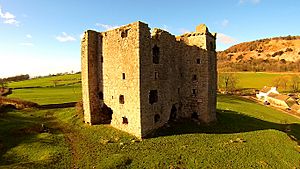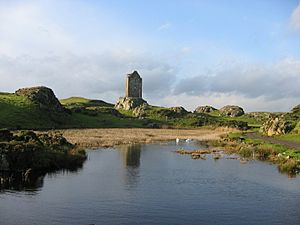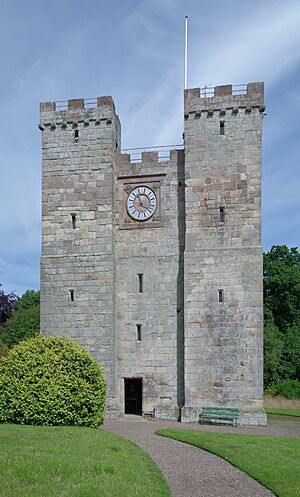Peel tower facts for kids

Peel towers (also spelled pele) are small, strong towers built a long time ago. They were found along the border between England and Scotland. Most were built between the mid-1300s and about 1600.
These towers were designed to be very strong for defense. They also showed the importance and wealth of the people who owned them. Peel towers were also used as watchtowers. People could light signal fires on top to warn others about danger coming.
Sometimes, the word "pele" also meant an enclosed area. This area was used to keep farm animals safe during attacks. The tower usually stood at one corner of this enclosure. Many of these walls are gone today. Some towers, called "vicar's peles," were in villages for everyone to use.
Why Were Peel Towers Built?
Peel towers were built in parts of Scotland, Northumberland, Cumberland, Westmorland, and North Riding of Yorkshire. Some were even as far south as Lancashire. They were built because of attacks from both English and Scottish groups, especially the Border Reivers. These groups often stole livestock like cattle.
In Scotland, a line of these towers was built in the 1430s. They stretched across the Tweed valley. This was to protect against invasions from the border areas. Many towers were built along the Tweed River.
In 1455, the Parliament of England made a rule. Each tower had to have an iron basket on its top. This basket was used to light smoke signals during the day or fire signals at night. This was a quick way to warn people about danger.
Besides being warning systems, these towers were also homes. The local lords and landowners lived in them with their families. Their helpers lived in simple huts outside the walls. When raiding parties arrived, everyone from the village could go inside the tower. They would stay there until the attackers left.
Where Can You See Peel Towers Today?
Many Peel towers still stand today, though some are just ruins. For example, Hawkshaw Tower in Scotland is no longer standing, but its spot is marked.
Some Peel towers were built next to churches. Embleton Tower in Embleton, Northumberland, is an example of a "vicar's pele." This means it was used by the local priest. Another example is at St Michael's Church, Burgh by Sands. It has a very strong tower at one end. St Cuthbert's, Great Salkeld, is also a good example.
Some towers were changed into bigger castles, like Penrith Castle. Others are now ruins. Many have been changed to be used in modern times. For instance, Embleton Tower is now part of a former vicarage. The tower on the Inner Farne is a home for bird wardens.
When converting these old towers, builders had to make big changes. They had to make it easier to get in, as the original entrances were hard to reach. They also added more and larger windows. A Peel tower in Hellifield, North Yorkshire, was even shown on a TV show called Grand Designs. It was turned from a ruin into a home and a bed-and-breakfast.
Darnick Tower is near Melrose and is still lived in today. It was built in 1425 by the Heiton family. It is seen as one of the best examples of a Borders peel tower. This tower stayed with the same family until 2016.
Canons Ashby House in the Midlands has one of the few Peel towers built outside the border region. It was built by John Dryden, a sheep farmer from Cumbria, who moved to Northamptonshire.
See also
 In Spanish: Torres Peel para niños
In Spanish: Torres Peel para niños




